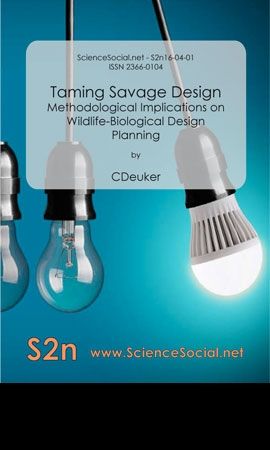Taming Savage Design-S2n16-04-01

| Author: CDeuker | |
| Price: FREE | |
| Taming Savage Design. Methodological Implications on Wildlife-Biological Design Planning | |
| Abstract Design Planning is a crucial objective in every science. In this paper fundamental methodological implications to design planning in wildlife monitoring are discussed. Starting with reflections about the ambition of wildlife monitoring, the semantical interconnectivity of 'nature' and 'culture' gives the first hint to multidimensionality and ambiguity in the focused area. Beyond this vagueness there is another problematic issue for methodical aspects in wildlife-biological design planning, that is non linearity of systems, stating the question of 'why measuring?' In addition to academic knowledge, decision making is one scope of applied sciences at least for preparing a discourse of conflicting interest. In situations of vague objectives with multidimensionality and nonlinear dynamics, the question of adequate rationality, as a methodological task, arises. Following the argumentation of Faucheux et al. in their paper "What Forms of Rationality for Sustainable Development?" [s. Faucheux, S., et al., 1995] I want to show that premises for methodological aspects of rationality in wildlife monitoring are equivalent with a notion of 'Panta Rhei' and a shift towards a procedural rationality. In the last section new methodological research strategies presuming a procedural rationality are presented, with a special focus on the difference of systematic and random error. Procedural rationality changes methodological aspects of methodical validation by taking fundamental system dimensions into account in contrast of a mere methodical system error ranking. |
|
| Click for more eBooks from this publisher. |
. . . . . . . . . . . . . . . . . . . . . . . . . . . . . . . . . . . . . . . . . . . . . . . . . . . . . . . . . . . . . . . . . . . . . . . . . . . . . . . . . . . . . . . . . . . . . . . . . . . . . . . . . . . . . . . . . . . . . . . . . . . . . . . . . . . . . . . . . . . . . . . . . . . . . . . . . . . . . . . . . . . . . . . . . . . . . . . . . . . . . . . . . . . . . . . . . . . . . . . . . . . . . . . . . . . . . . . . . . . . . . . . . . . . . . . . . . . . . . . . . . . . . . . . . . . . . . . . . . . . . . . . . . . . . . . . . . . . . . . . . . . . . . . . . . . . . . . . . . . . . . . . . . . . . . . . . . . . . . . . . . . . . . . . . . . . . . . . . . . . . . . . . . . . .


